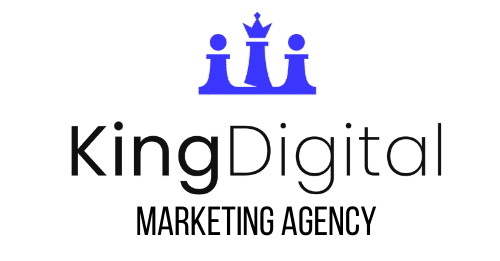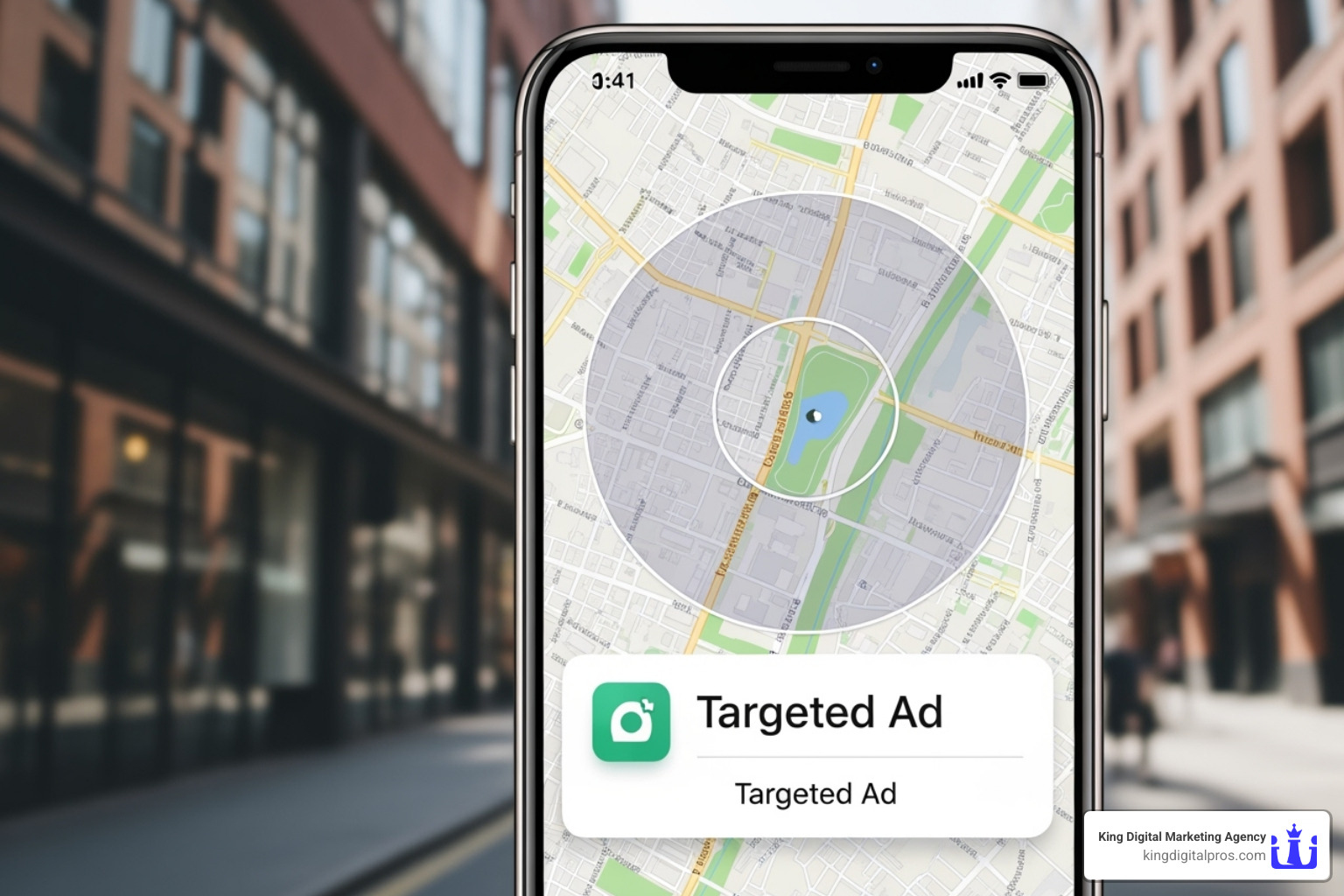Why Geofencing Marketing Software is Changing Local Business Success
Geofencing Marketing Software is a location-based tool that creates virtual boundaries around specific geographic areas. It automatically delivers targeted ads and notifications to potential customers’ mobile devices when they enter or exit these zones.
Quick Answer for Busy Business Owners:
- What it does: Creates invisible fences around locations (your store, competitors, events) to trigger ads.
- How it works: Uses GPS, Wi-Fi, and cellular data to detect when smartphones enter your target area.
- Key benefits: Up to 20x more effective than traditional advertising, drives foot traffic, and reduces wasted ad spend.
- Best for: Restaurants, retail stores, and service businesses wanting to capture nearby customers.
- Getting started: Choose a platform, set target areas, create compelling offers, and launch campaigns.
With over 81% of Americans owning smartphones, geofencing taps into an always-connected audience. What makes it so powerful for local businesses is timing. Instead of hoping your ads reach the right people, geofencing delivers your message when potential customers are physically near your location or even walking past a competitor.
Imagine someone walks by your coffee shop at 8 AM. That’s the perfect moment to send them a “Free pastry with coffee purchase” notification. This level of precision is best by traditional advertising.
The technology uses GPS, Wi-Fi, and cellular data to create virtual perimeters. When a mobile device crosses these boundaries, it triggers pre-programmed actions like displaying ads or sending push notifications.
I’m Bernadette King, founder of King Digital Marketing Agency. I’ve seen how geofencing strategies drive foot traffic and boost sales. It’s about connecting with customers at the exact moment they’re ready to buy.
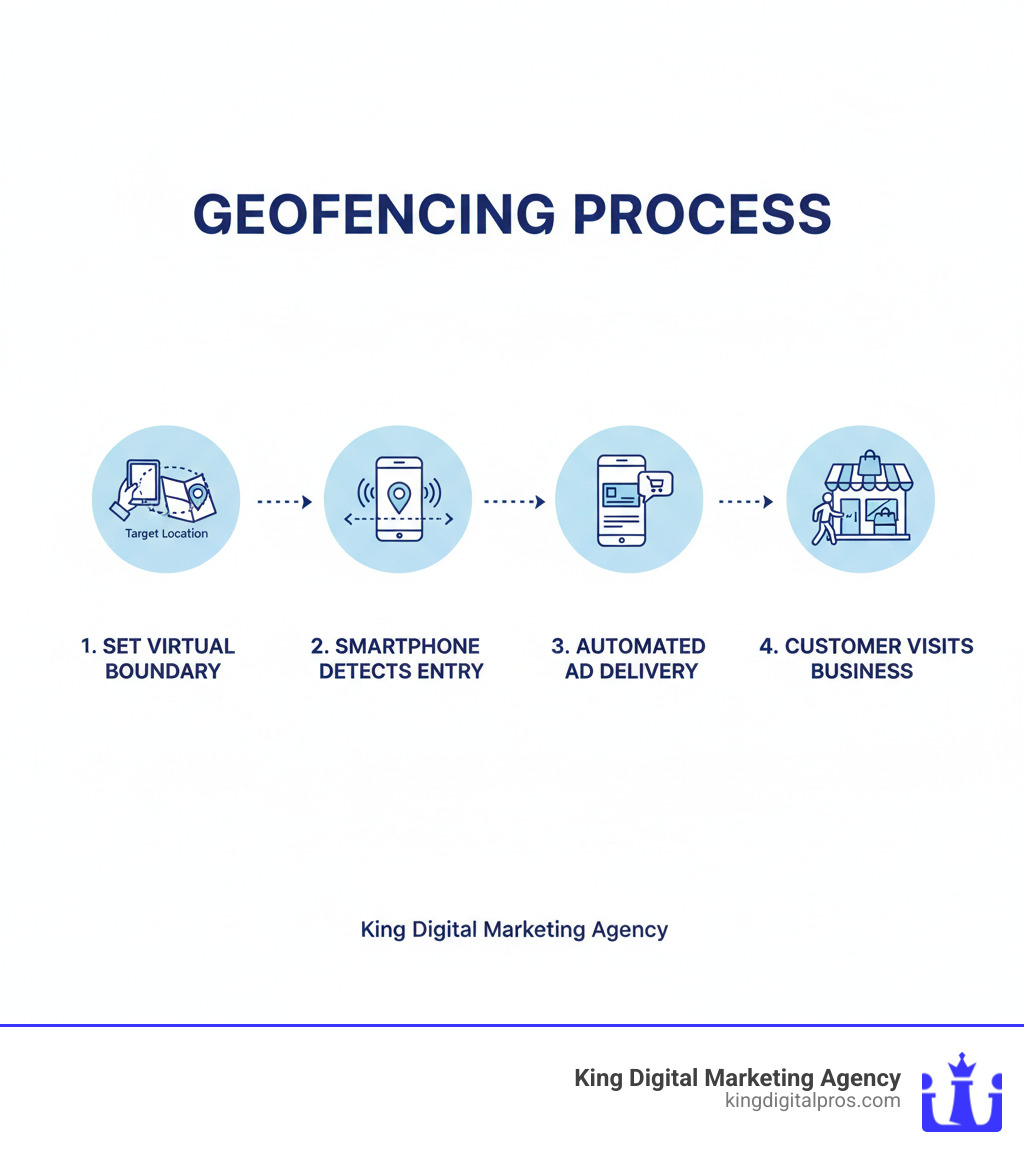
Understanding the Fundamentals of Geofencing Technology
Geofencing Marketing Software works by creating virtual boundaries around real-world locations using GPS coordinates. When a smartphone crosses these digital fences, it triggers a pre-programmed marketing message. This requires user permission, as they must have location services enabled and opt-in to receive notifications. It’s a consent-based way to connect with interested customers.
Unlike general geotargeting that blankets an entire city with ads, geofencing is surgical. You can target a three-block radius around a competitor or the exact footprint of a local festival. This precision is what makes Geofencing Marketing so effective for local businesses.
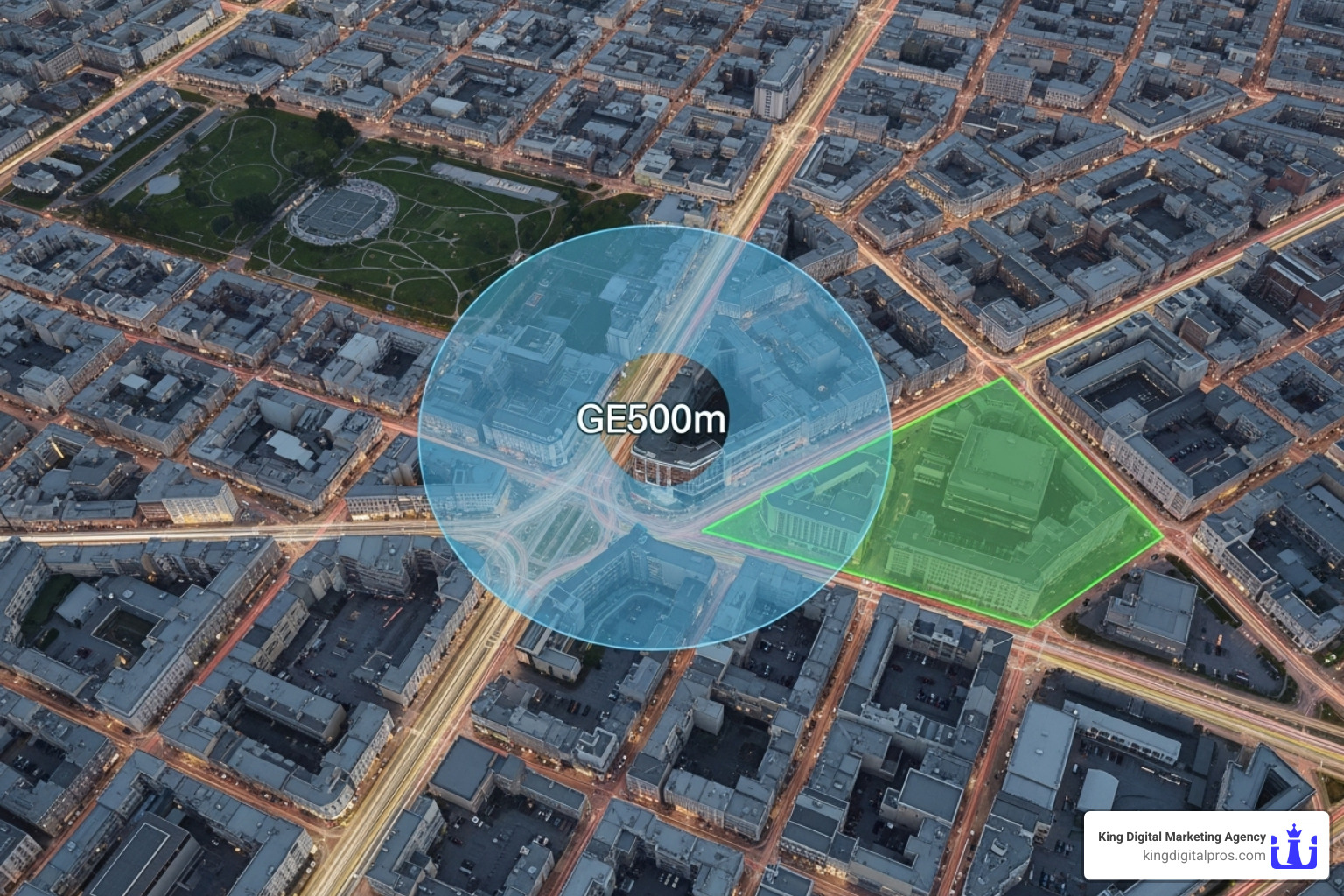
How Geofencing Works
Geofencing relies on a combination of technologies already in every smartphone:
- GPS Satellites: Provide highly accurate location data, especially outdoors.
- Wi-Fi Networks: Help triangulate a phone’s position indoors or in dense urban areas by detecting nearby signals.
- Cellular Towers: Use signal strength from multiple towers to pinpoint a device’s location.
Some specialized systems use RFID for very close-range detection, but most platforms use the first three. You define a virtual fence in your software, which then monitors for devices entering or leaving the zone. When a device crosses the boundary, your pre-planned action – like an ad or push notification – is triggered instantly. According to research from the location intelligence industry, this timeliness makes location-based marketing up to 20 times more effective than traditional ads.
Types of Geofences and Targeting
- Radius Geofences: Simple circles drawn around a central point, ideal for targeting a general area around your store. However, they can include irrelevant areas like a busy highway.
- Polygon Geofences: Custom shapes that follow specific outlines like property lines or building footprints. This precision allows you to target the sidewalk in front of a competitor, dramatically improving accuracy.
- Static vs. Dynamic: Static geofences are fixed to permanent locations like your storefront. Dynamic geofences can move or change, but are less common for standard marketing.
It’s also important to understand geotargeting versus geofencing. Geotargeting casts a wide net over a city or region. Geofencing sets a precise trap, triggering actions only when someone physically enters your defined area. For driving immediate foot traffic or targeting competitors, geofencing is the superior tool.
The Core Benefits and Use Cases of Geofencing
Geofencing Marketing Software transforms foot traffic into customers by delivering the right message at the right moment, like a coffee shop offering a deal to someone walking by at 8 AM.
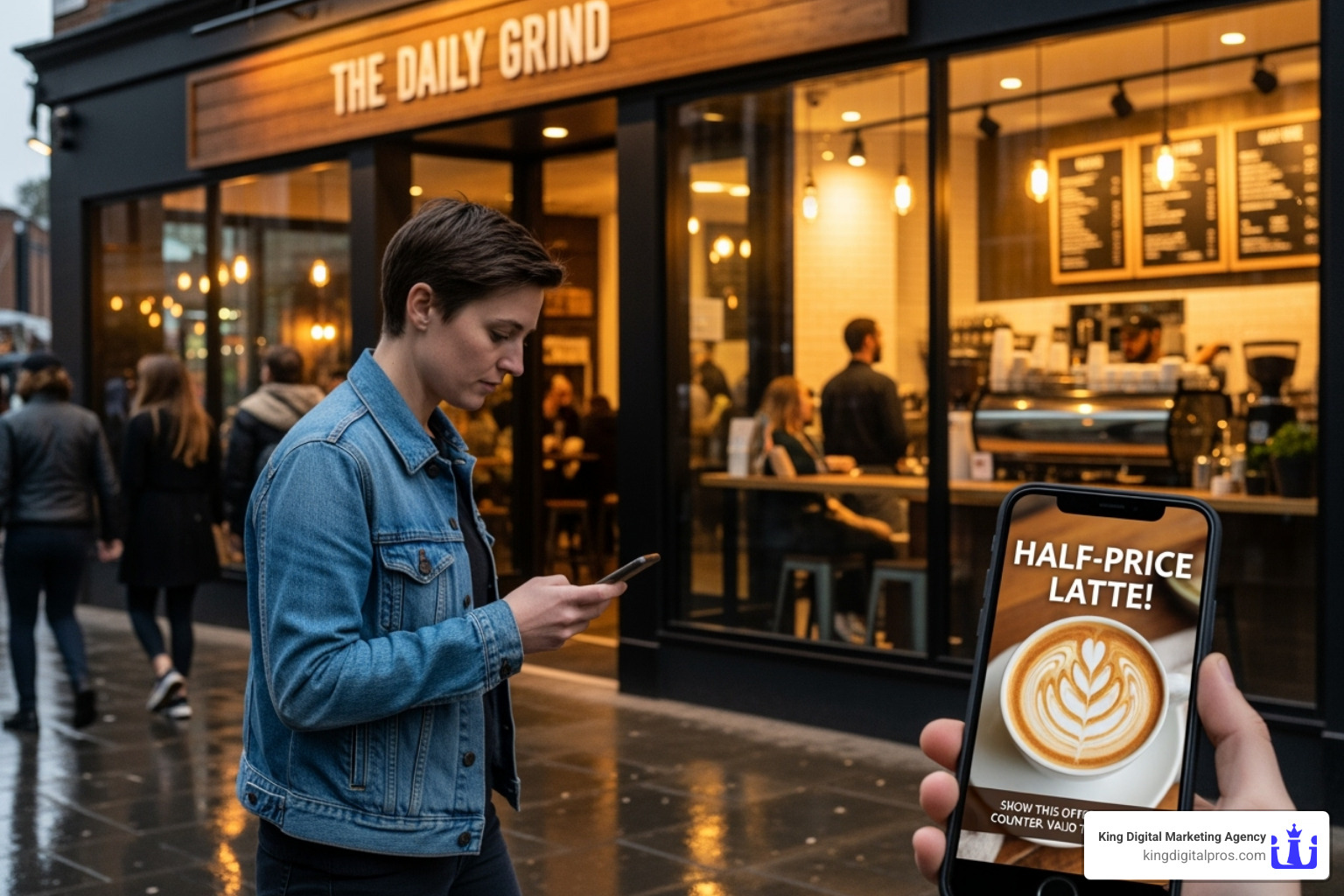
The primary benefits are clear and impactful:
- Increased Foot Traffic: Nudging nearby shoppers to step inside can be 20 times more effective than traditional ads.
- Improved Brand Awareness: Your message creates a top-of-mind presence, planting a seed for future purchases.
- Reduced Ad Waste: Focus your budget only on people physically near your business, ensuring every dollar works harder.
- Higher Conversion Rates: The combination of timing and relevance prompts immediate action from interested customers.
- Competitive Advantage: Gain insights into foot traffic patterns and customer behavior to make smarter business decisions and Attract More Customers.
Driving Business Growth with Hyper-Local Targeting
Hyper-local targeting is the real game-changer. Instead of targeting a city, you can reach people on your block.
- Targeting Competitor Locations: Legally and effectively deliver a compelling counter-offer to customers visiting a rival’s store.
- Event Targeting: Create geofences around festivals, trade shows, or concerts to capture attendee attention.
- Audience Segmentation: Identify and target specific groups, like gym-goers or luxury shoppers, based on their location history.
- Real-Time Offers: Push timely specials, like lunch deals during the noon rush or flash sales to mall shoppers.
- Customer Loyalty: Automatically thank customers as they leave or surprise regulars with exclusive offers to Grow Local Business through genuine connection.
Common Industry Applications
Geofencing is versatile and effective across many industries:
- Retail: Send discount codes to shoppers in a specific district to turn browsers into buyers.
- Restaurants: Deliver lunch specials to nearby office workers or happy hour deals to people leaving work.
- Real Estate: Target active house hunters visiting open houses with similar listings or consultation offers.
- Events: Promote your booth to convention attendees or offer discounts to concert-goers.
- Automotive: Target shoppers at dealership lots with service reminders, test drive offers, or trade-in evaluations.
- Home Services: HVAC companies can target neighborhoods during extreme weather, or plumbers can offer maintenance deals in areas they are already servicing.
Choosing the Right Geofencing Marketing Software Platform
Selecting the right Geofencing Marketing Software is critical for success. The best platform for a national chain may be overkill for a local bakery, while a budget option might lack the necessary precision. Key evaluation criteria include core functionality (like polygon geofencing), usability, scalability for future growth, and responsive customer support.
Here’s what you can typically expect from different software tiers:
| Feature | Basic Tier | Pro Tier | Enterprise Tier |
|---|---|---|---|
| Targeting Precision | Radius geofences, basic location | Radius & polygon geofences, points of interest | Hyper-accurate polygon, dynamic, behavioral targeting |
| Geofence Limit | Limited number (e.g., 50-100) | Moderate number (e.g., 500-1000) | Unlimited or very high |
| Analytics Depth | Basic impressions, clicks, simple reports | Detailed campaign metrics, foot traffic attribution | Real-time dashboards, custom reports, ROI analysis |
| Ad Formats | Display ads, basic push notifications | Display, video, OTT/CTV, rich push | All formats, highly customizable |
| Audience Segmentation | Limited (e.g., broad demographics) | Basic behavioral, retargeting | Advanced behavioral, custom audiences, CRM integration |
| Campaign Automation | Simple triggers | Multi-step workflows, scheduling | AI-powered optimization, complex sequences |
| Integration Options | Basic APIs, few marketing platforms | CRM, analytics, some ad exchanges | Extensive APIs, full marketing stack, custom solutions |
| Customer Support | Email, self-service knowledge base | Email, chat, dedicated account manager | Priority support, strategic consulting |
| Pricing Model | Per geofence, per notification, or flat fee | Tiered subscriptions based on usage | Custom pricing, enterprise agreements |
For a deeper dive, our Geofencing Marketing Software Ultimate Guide offers a complete decision-making process.
Key Features to Look For in Geofencing Marketing Software
- Targeting Accuracy: Prioritize platforms that can pinpoint locations within a few meters. This is the difference between reaching a customer in your store versus one three blocks away.
- Audience Segmentation: Go beyond generic messages. Target gym-goers with protein smoothie ads and office workers with espresso deals to make campaigns feel relevant, not spammy.
- Ad Formats: Flexibility is key. Use display ads for awareness, video to showcase products, push notifications for urgency, and Connected TV ads to reach customers at home.
- Campaign Automation: Set up rules to automatically send offers at optimal times, like lunch specials at noon or happy hour promotions at 5 PM.
- Integration with CRM: Connect geofencing data to your Lead Management Software to follow up with potential customers who visited your location but didn’t buy.
Measuring Success with Your Geofencing Marketing Software
Geofencing provides metrics that traditional advertising can’t. Look for intuitive reporting dashboards and robust analytics capabilities that show foot traffic patterns and visit duration. The most powerful feature is conversion tracking and foot traffic attribution, which directly connect your digital ad spend to real-world store visits. Also, track website visit measurement to capture the full customer journey. This allows for a clear calculation of Return on Ad Spend (ROAS), which the Interactive Advertising Bureau notes is significantly higher for location-based advertising.
Addressing Privacy and Compliance
Trust is built on responsible data handling. Ensure your platform prioritizes user data privacy. Opt-in consent is essential; users must agree to location tracking. Look for GDPR compliance and data anonymization to protect individuals. Be transparent in your policies, as recommended by the Federal Trade Commission. Customers who trust you with their data become your most loyal advocates.
Challenges and the Evolution of Geofencing
While powerful, Geofencing Marketing Software has limitations. Understanding these challenges helps create more effective campaigns with realistic expectations.
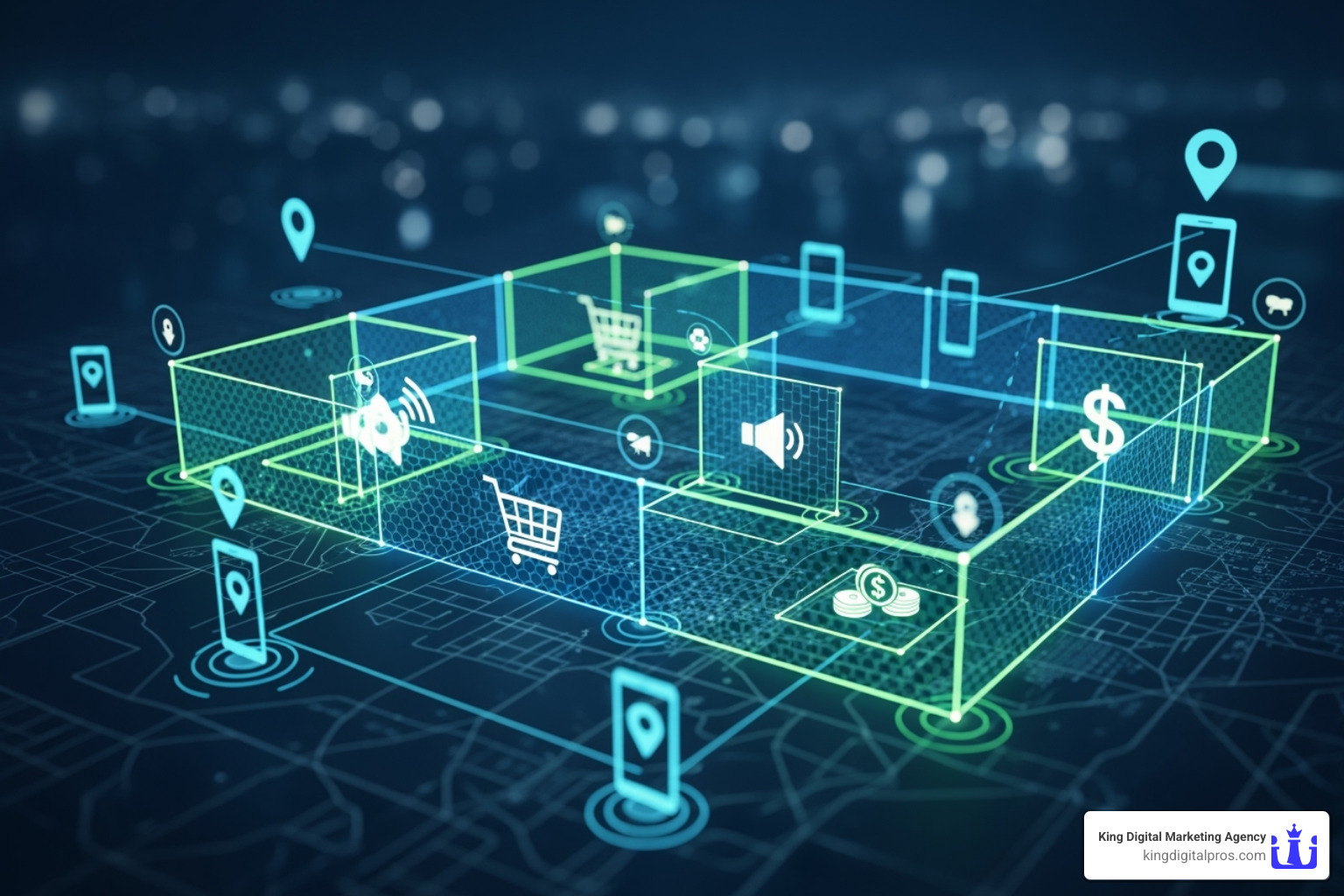
Common challenges include:
- Inconsistent Triggers: Device settings, battery life, and signal strength can cause unreliable triggers.
- Ad Fatigue: Bombarding users with notifications leads to them opting out. Frequency and relevance are key.
- Location Accuracy Issues: Dense urban areas, indoor malls, and remote locations can interfere with GPS signals, reducing precision.
- Battery Drain: Background location tracking uses device battery, a concern for privacy-conscious consumers.
For a broader perspective, the Times of India offers valuable insights about geofencing functionality and its pros and cons.
Future Trends in Geofencing Marketing
Despite these problems, the technology is evolving rapidly:
- Artificial Intelligence (AI) Integration: AI is a game-changer, analyzing location data to predict customer behavior, optimize message timing, and suggest ideal geofence placements.
- Hyper-Personalization: Future systems will deliver unique messages based on individual shopping history and real-time context, moving beyond generic offers.
- Programmatic Advertising: Integration with these platforms automates bidding and ad placement, making campaigns more efficient and scalable.
- IoT Device Integration: Possibilities are expanding beyond smartphones to smart cars and home devices. The Federal Trade Commission provides guidance on privacy considerations for these new technologies.
- Advanced Analytics: We are moving beyond simple entry/exit alerts to understanding complete customer journeys and using predictive modeling.
These innovations are making marketing feel less like advertising and more like timely, helpful assistance.
Frequently Asked Questions about Geofencing Marketing
Here are answers to the most common questions business owners have about Geofencing Marketing Software.
What is a geofencing platform?
A geofencing platform is the software used to create virtual boundaries (geofences) around real-world locations. It serves as a command center to define target areas, design ads, and automatically trigger messages when a user’s device enters or exits a geofence. A good platform manages the entire process, from setup to analytics.
How successful is geofencing?
Geofencing is highly successful due to its precision, relevance, and timing. Studies show it can be up to 20 times more effective than traditional advertising. By reaching customers who are physically nearby and often already in a buying mindset, it drives higher engagement and conversion rates. I’ve seen local businesses increase foot traffic by over 30% using targeted geofence campaigns.
How do you use geofencing for marketing?
Using geofencing for marketing involves three main steps:
- Define Your Target Area: Use the software to draw a geofence around your store, a competitor’s location, or an event venue.
- Create a Compelling Offer: Design a timely and relevant ad or notification, such as a limited-time discount or a new product announcement.
- Launch and Automate: Set the campaign to run automatically. The platform will deliver your message to users who enter the geofenced zone.
The goal is to drive a specific action, like a store visit or website click. According to the Mobile Marketing Association, this approach can significantly increase purchase intent.
Conclusion
After diving deep into Geofencing Marketing Software, one thing becomes crystal clear: this isn’t just another marketing trend that’ll fade away. It’s a fundamental shift in how smart businesses connect with their customers.
Think about it – we’ve moved from hoping our ads reach the right people to knowing exactly when potential customers are walking past our doors. That’s not just progress; that’s a marketing revolution. The ability to create virtual boundaries using GPS, Wi-Fi, and cellular data means we can deliver the perfect message at the perfect moment, turning casual passersby into loyal customers.
The numbers don’t lie either. When we can achieve up to 20 times more effectiveness than traditional advertising while simultaneously reducing wasted ad spend, we’re talking about a game-changer for local businesses. Whether you’re running a cozy coffee shop, managing multiple retail locations, or providing home services, Geofencing Marketing Software levels the playing field in ways we couldn’t imagine just a few years ago.
But here’s what I’ve learned after years of helping businesses implement these strategies: the technology is only as good as the strategy behind it. It’s not enough to simply set up a geofence and hope for the best. Success comes from understanding your customers’ journey, respecting their privacy, and crafting messages that genuinely add value to their day.
The future looks even brighter. With AI integration making campaigns smarter and hyper-personalization making messages more relevant, we’re just scratching the surface of what’s possible. Yet even as the technology evolves, the core principle remains the same: be there when your customers need you most.
At King Digital Marketing Agency, we’ve seen how strategic implementation transforms local businesses. From small family-owned shops to growing service companies, the businesses that accept location-based marketing with thoughtful planning and genuine customer focus are the ones that thrive.
Ready to see what Geofencing Marketing Software can do for your business? The opportunity to connect with customers in your immediate area has never been more accessible or more powerful. To implement a results-driven campaign that actually drives foot traffic and grows your customer base, explore our Geofencing Software solutions and find how we can help your business reach the customers who are already nearby and ready to buy.
